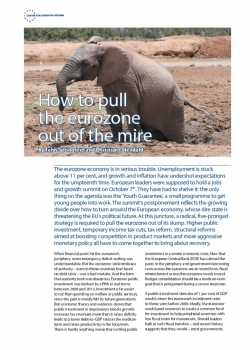
How to pull the eurozone out of the mire
The eurozone economy is in serious trouble. Unemployment is stuck above 11 per cent, and growth and inflation have undershot expectations for the umpteenth time. European leaders were supposed to hold a jobs and growth summit on October 7th. They have had to shelve it: the only thing on the agenda was the ‘Youth Guarantee’, a small programme to get young people into work. The summit’s postponement reflects the growing divide over how to turn around the European economy, whose dire state is threatening the EU’s political future. At this juncture, a radical, five-pronged strategy is required to pull the eurozone out of its slump. Higher public investment, temporary income tax cuts, tax reform, structural reforms aimed at boosting competition in product markets and more aggressive monetary policy all have to come together to bring about recovery.
When financial panic hit the eurozone’s periphery, some emergency deficit-cutting was understandable. But the eurozone-wide embrace of austerity – even in those countries that faced no debt crisis – was a bad mistake. And the form that austerity took was disastrous. Eurozone public investment was slashed by a fifth in real terms between 2009 and 2013. Investment is far easier to cut than spending on welfare or public services, since the pain is mostly felt by future generations. But economic theory and evidence shows that public investment in depressions boosts growth, increases tax revenues more than it raises deficits, leads to a lower debt-to-GDP ratio in the medium term and raises productivity in the long term. There is hardly anything worse than cutting public investment in a severe economic crisis. Now that the European Central Bank (ECB) has calmed the panic in the periphery and government borrowing costs across the eurozone are at record lows, fiscal retrenchment across the eurozone needs to end. Budget consolidation should be a medium-term goal that is postponed during a severe recession.
A public investment stimulus of 1 per cent of GDP would return the eurozone’s investment rates to those seen before 2009. Ideally, the eurozone would pool resources to create a common fund for investment to help peripheral countries with less fiscal room for manoeuvre. Should leaders balk at such fiscal transfers – and recent history suggests that they would – most governments, except Greece and perhaps Italy, could spend more unilaterally. This would be entirely legal, if eurozone leaders applied the Stability and Growth Pact’s ‘exceptional circumstances’ rule, which allows countries to miss deficit targets in "periods of severe downturn". Fiscal over-achievers like Germany need to spend much more.
Since public investment takes time to work, it should be complemented by tax cuts that can be made relatively quickly. How they affect the economy depends on which taxes are cut and how these cuts are financed. In his recent speech at the annual gathering of central bankers in Jackson Hole, Mario Draghi argued that the eurozone needed ‘balanced budget’ tax cuts, which would be offset by cuts in public expenditure. But spending cuts directly reduce demand while a proportion of any tax cuts will be saved by consumers. Draghi’s approach is therefore likely to reduce growth, not raise it.
A better way to cut taxes without reducing revenue is to change the composition of the tax system, away from labour taxes that make European workers comparatively expensive, and towards taxes on wealth, inheritances, property or carbon emissions. These shifts would be likely to have a positive impact on growth over the short and medium term.
However, given the extreme weakness of the European economy, governments should also enact lump-sum income tax rebates for one year, which should be financed by borrowing, not spending cuts. This kind of tax cut makes its biggest impact on household expenditure, as the US experience shows. Germany, in particular, could stimulate its domestic economy in this way.
On the supply side, there are many headwinds buffeting the European economy: an ageing society; slowing growth in educational attainment; and a slowdown in the labour force participation of women, even before the crisis. Since the workforce is growing slowly in some countries and shrinking in others, Europe will have to make the workers it has more productive. This requires supply-side reform.
In 2011, the OECD estimated the impact of structural reforms in Europe on real GDP. It found that the largest gains would arise from promoting competition between firms; then tax reforms to reduce taxes on labour and income, and increase them on wealth, consumption and carbon; then investment in education in countries where attainment lags behind the OECD average; then labour market reform, and, finally, greater investment in research and development.
The reforms that the EU has so far pursued have not followed this order of priorities, focussing obsessively on labour market reforms in an attempt to boost ‘competitiveness’. This puts even more short-term strain on the economy as, in the absence of demand, more people are fired than hired. Structural reforms need a new focus – on tackling barriers to competition in product markets, especially in services, which would raise productivity – and as part of the investment stimulus governments should raise expenditure on education, training and research and development.
A looser fiscal policy and supply-side reform would not suffice, however: the ECB also needs to do more. While it has unveiled measures to buy private assets directly in markets, and supply another round of longer-term cheap loans to banks, this is unlikely to do enough to raise eurozone inflation to the ECB’s target. In part, this is because banks and financial markets have failed to pass on monetary stimulus to the real economy in the way the ECB hoped. Belatedly, the eurozone is forcing banks to recapitalise, which is crucial to make monetary policy work better. But the ECB must also shape the expectations of consumers and firms about their future incomes and prices. In addition, threats of unlimited intervention by a central bank are much more effective than limited fiddling in financial markets, as the ECB learnt when its Outright Monetary Transactions programme arrested bond market panic.
Therefore the ECB should announce two new measures. First, that it intends to make up for excessively low current inflation with somewhat higher inflation in the future, leading to an average of two per cent inflation over the next five years. This will improve expectations of future incomes and prices, and push down the euro, which will help exporters. Second, in order to make that commitment credible, the ECB should announce unlimited purchases of assets of its own choosing, private and public, domestic and foreign, until the target has been reached.
Unless policy-makers take decisive action to raise growth and inflation rates, public debt in a number of member-states will become unsustainable, starting with Italy. Germany remains the major obstacle to change. But without a fresh approach, the political backlash against the euro and the EU as a whole could become impossible to contain. It is not in Berlin’s interest to preside over economic slump and political turmoil.
John Springford is a senior research fellow at Christian Odendahl is chief economist at the Centre for European Reform.

